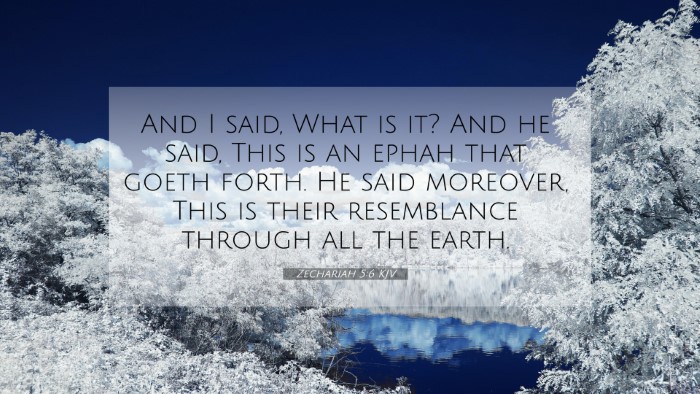Old Testament
Genesis Exodus Leviticus Numbers Deuteronomy Joshua Judges Ruth 1 Samuel 2 Samuel 1 Kings 2 Kings 1 Chronicles 2 Chronicles Ezra Nehemiah Esther Job Psalms Proverbs Ecclesiastes Song of Solomon Isaiah Jeremiah Lamentations Ezekiel Daniel Hosea Joel Amos Obadiah Jonah Micah Nahum Habakkuk Zephaniah Haggai Zechariah MalachiZechariah 5:6 Similar Verses
Zechariah 5:6 Cross References
And I said, What is it? And he said, This is an ephah that goeth forth. He said moreover, This is their resemblance through all the earth.
Uncover the Rich Themes and Topics of This Bible Verse
Listed below are the Bible themes associated with Zechariah 5:6. We invite you to explore each theme to gain deeper insights into the Scriptures.
Zechariah 5:6 Cross Reference Verses
This section features a detailed cross-reference designed to enrich your understanding of the Scriptures. Below, you will find carefully selected verses that echo the themes and teachings related to Zechariah 5:6 KJV. Click on any image to explore detailed analyses of related Bible verses and uncover deeper theological insights.

Amos 8:5 (KJV) »
Saying, When will the new moon be gone, that we may sell corn? and the sabbath, that we may set forth wheat, making the ephah small, and the shekel great, and falsifying the balances by deceit?

Ezekiel 44:10 (KJV) »
And the Levites that are gone away far from me, when Israel went astray, which went astray away from me after their idols; they shall even bear their iniquity.
Zechariah 5:6 Verse Analysis and Similar Verses
Understanding Zechariah 5:6
Zechariah 5:6 states: "And I said, What is it? And he said, This is an ephah that goeth forth. He said moreover, This is their resemblance throughout the earth."
This verse introduces a vision that speaks profoundly about the sinfulness and wickedness of the people represented by the ephah, a measurement basket. This imagery serves to communicate themes of judgment, accountability, and the divine response to human behavior.
Summary of Biblical Insights
Combining insights from public domain commentaries, we can glean deeper meaning:
- Matthew Henry: This ephah symbolizes the measure of iniquity that the Lord is observing among His people. Henry conveys the clear instruction that sin cannot be ignored as it fills the land, and God's attention will lead to eventual consequences.
- Albert Barnes: Barnes describes the ephah as a representation of the complete sinfulness within Israel, indicating that there is a uniformity in the moral decay. He notes that the ephah travels throughout the earth, denoting the pervasive nature of sin.
- Adam Clarke: Clarke emphasizes the vision's symbolism, going further to articulate how the ephah encapsulates the spirit of the people—a weight of their transgressions measured by God. He points out the significance of God’s judgment being inescapable.
Significance of the Ephah
The ephah is not just a physical measure; it symbolizes a spiritual state:
- Judgment: It indicates how God measures sin and its eventual judgment.
- Universal Applicability: The ephah going forth signifies that all nations are subject to divine justice.
- Corporate Responsibility: It urges the community to recognize their collective sin and the weight it carries before God.
Connecting Themes and Cross-References
This verse can be linked thematically with numerous passages in the Bible, offering a rich tapestry of connections and deeper understanding:
- Isaiah 5:20: Explores the concept of calling good evil and vice versa, resonating with the themes found in Zechariah regarding moral corruption.
- Jeremiah 14:10: Discusses God's judgment on His people for their wickedness, connecting to the accountability highlighted in Zechariah.
- Amos 8:5-6: Describes the trading of justice for dishonesty, mirroring the moral failures represented by the ephah.
- Revelation 6:6: Relates to weights and measures, reinforcing the concept of divine justice and accountability.
- Hosea 4:1: Speaks about weighty judgments on the land due to lack of truth and mercy, paralleling the warnings in Zechariah.
- Proverbs 11:1: Touches on the Lord's disdain for dishonest scales, echoing the implications of wicked measurements in Zechariah.
- Micah 6:11-12: Discusses the corruption among God's people and their practices that reflects the iniquity of the ephah.
- Matthew 7:2: Jesus speaks on the measure used to judge others, relating back to the theme of accountability found in Zechariah.
- Romans 2:6: Emphasizes God's judgment according to works, connecting to the accountability implied in the judgment of the ephah.
- Galatians 6:7: Reinforces the principle of reaping what one sows, which is a foundational concept in understanding consequences of sin highlighted in Zechariah.
Conclusion
In Zechariah 5:6, we see a multifaceted approach to understanding the moral state of the people through vivid imagery and profound symbolism. This text encourages reflection on personal and collective responsibility regarding sin and the necessity of alignment with God's standards. By examining cross-references, we can unravel deeper meanings while understanding how these scriptures link as part of the grand narrative of God's message throughout the Bible.
Tools for Further Study
For those seeking to delve deeper:
- Consider using a Bible concordance to identify related terms and themes.
- Utilize a cross-reference Bible study guide to find interconnections across scriptures.
- Explore Bible chain references for thematic study.


